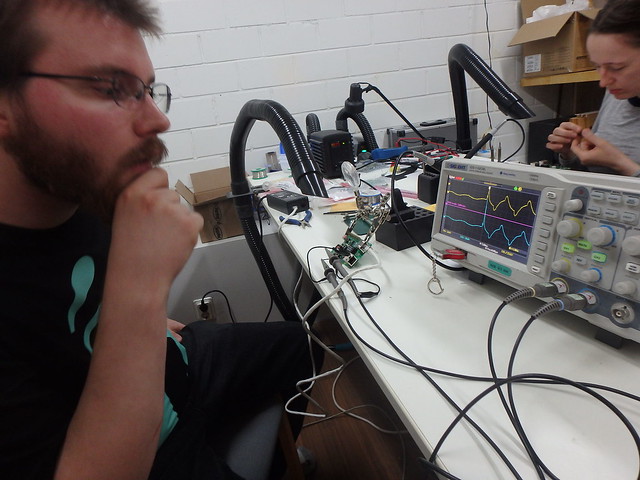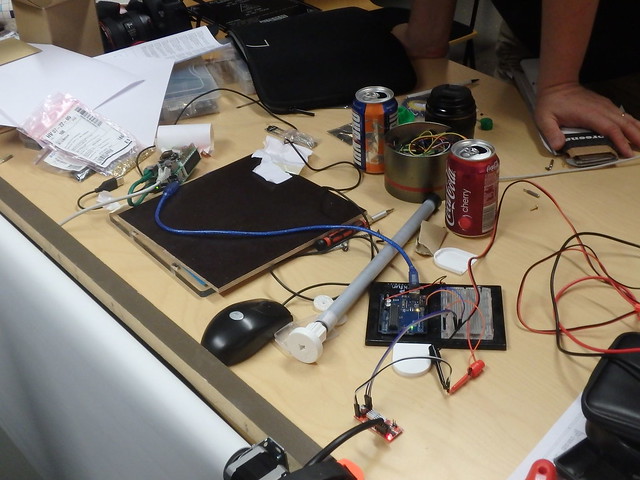-
ELL-i RasPoE LIVE on IndieGoGo!
05/27/2015 at 15:32 • 0 commentsELL-i RasPoE IndieGoGo campaign is LIVE
So, we finally decided on a name: RasPoE
We also opened the IGG crowdsurfing campaign so as to make a run of the boards for us, you, everybody and their dogs. And cats.
This far we have tested the board against 802.3af and 802.3at PSE units from Juniper, Cisco, Zyxel, D-Link, Phi Hong and several other vendors. Integrated PSE is architecturally more pretty but midspan PSE works just as fine.
Also, our boards do protect the Raspberry Pi network chip from frying when unplugging the cable while the system is running. Cutting the cable in mid-run is also okay, but I forgot to take a video of it.
-
Hackathon aftermath
05/26/2015 at 07:08 • 0 commentsMay 24
We setup the Helsinki Hacklab for our hackathon. It was a quick matter of connecting our PoE switch to rack and presenting the Raspberrys and PoE shields, PoELL-i Nucleos and various electronics modules, parts and shields. Soon we were having music over Ethernet.
![]() We assembled a few of the new PoE-shields,
We assembled a few of the new PoE-shields,![]() It was very interesting to see what happens when the area has a lot of creative people, and facilities to support them around. Helsinki Hacklab had Ethernet sockets already available all over the place, and with our PoE switch we could enable PoE in any socket in less than a minute.
It was very interesting to see what happens when the area has a lot of creative people, and facilities to support them around. Helsinki Hacklab had Ethernet sockets already available all over the place, and with our PoE switch we could enable PoE in any socket in less than a minute.Whenever there was a convenient spot for building a project, things happened at amazing pace. Want to try if that stepper motor driver can drive the curtains, but don't want to risk your laptop to higher-than-USB-voltages? Plug in a Raspberry with PoE, power Arduino through Raspberry Pi's USB and you're ready to go!
![]()
There was something amazing created in our hackathon, and we feel it deserves it's own in-depth writeup. Stay tuned to find out what it was! In meanwhile, join in our mailing list here and we'll email you before our campaign starts so you can snatch those Early Bird rewards!
-
New Raspberry Pi PoE boards on oscilloscope
05/26/2015 at 07:01 • 0 commentsMay 23
The new boards with protection diodes have arrived. After a quick soldering, we had a beautiful proto on our desk.
![]() We tested the boards, full 100MBit/s speed was reached. The next test was to see if our clamping diodes work as they should, so it was oscilloscope o'clock.
We tested the boards, full 100MBit/s speed was reached. The next test was to see if our clamping diodes work as they should, so it was oscilloscope o'clock.![]()
![]() The protection diode clamps the voltage spike to roughly 9 volts. Next thing to do was to plug the cable in and out ~100 times and see if the board would still connect. And connect it does! Now all that remains is to do a few cosmetic adjustments and launch the campaign.
The protection diode clamps the voltage spike to roughly 9 volts. Next thing to do was to plug the cable in and out ~100 times and see if the board would still connect. And connect it does! Now all that remains is to do a few cosmetic adjustments and launch the campaign.I copied this over from the ELL-i blog where we are posting more stuff. Also, the blog was written by Otso but as he has better things to do, I'm chosen for this copying task.
-
Looking for testers
05/18/2015 at 11:59 • 0 commentsOur newest boards are currently in customs waiting to be cleared, they will arrive in time for our Hackathon next weekend.
We took this opportunity to make a few final adjustments to design. We added a connection for a pin header at the output before fuse in case someone wants to power some external load. To further help with external loads we also left a place for output voltage adjustment resistors so people can tweak the output to suit their needs.
We also pulled the DC/DC module a bit inwards to the board so it will have a bit more space between HiFiBerry DAC+ RCA-connector and DC/DC transformer.
We're going to launch the crowdfunding campaign soon. In meanwhile, if you want to receive one board ASAP we can send you the bare boards and parts at no markup. If you're interested in assembling one board and giving it a try, contact us at indie@ell-i.org and we'll arrange things from there.
-
Two steps forward, one backward
05/06/2015 at 06:53 • 0 commentsOtso, our electrical engineer, noticed that our nice boards can at times be destructive. Naturally we wish our boards were of high quality and destroying your precious Raspberry Pi is far from that.
This is related to power spikes at the moment of cable disconnect, so a solution is in the works now that we know the culprit. Zeners as a first fix and perhaps transzorbs for a more real solution. New board design anyway.
![]()
![]()
RasPoE - ELL-i PoE for RasPi
Power over Ethernet 802.3af isolated power supply board for powering your Raspberry Pi B+ or model 2 and its peripherals.
 Teemu Hakala
Teemu Hakala We assembled a few of the new PoE-shields,
We assembled a few of the new PoE-shields, It was very interesting to see what happens when the area has a lot of creative people, and facilities to support them around. Helsinki Hacklab had Ethernet sockets already available all over the place, and with our PoE switch we could enable PoE in any socket in less than a minute.
It was very interesting to see what happens when the area has a lot of creative people, and facilities to support them around. Helsinki Hacklab had Ethernet sockets already available all over the place, and with our PoE switch we could enable PoE in any socket in less than a minute.
 We tested the boards, full 100MBit/s speed was reached. The next test was to see if our clamping diodes work as they should, so it was oscilloscope o'clock.
We tested the boards, full 100MBit/s speed was reached. The next test was to see if our clamping diodes work as they should, so it was oscilloscope o'clock.
 The protection diode clamps the voltage spike to roughly 9 volts. Next thing to do was to plug the cable in and out ~100 times and see if the board would still connect. And connect it does! Now all that remains is to do a few cosmetic adjustments and launch the campaign.
The protection diode clamps the voltage spike to roughly 9 volts. Next thing to do was to plug the cable in and out ~100 times and see if the board would still connect. And connect it does! Now all that remains is to do a few cosmetic adjustments and launch the campaign.

